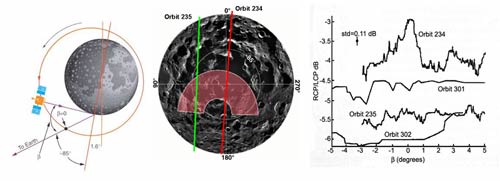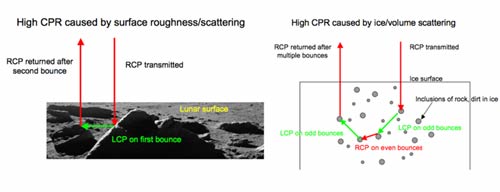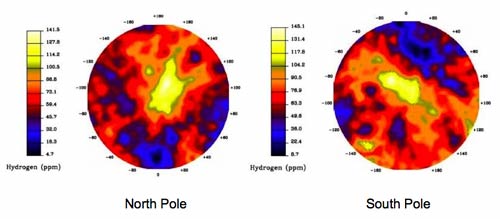
Ice on the MoonA review of the lunar polar ice controversy, how it will be resolved, and what it means to our return to the Moonby Paul Spudis
|
| Is there water ice on the Moon? If so, does it exist in accessible quantities making a permanent human presence on the Moon easier? What additional information is needed to resolve this controversy? |
Constrained to near-equatorial regions by operational and safety considerations, the poles weren’t investigated by the Apollo missions. But the idea that water might exist in these forbidding, dark cavities was kept alive in a paper by Jim Arnold of the University of California. Arnold was well aware that the Apollo samples were bone-dry, but noted that Brown’s original arguments were still valid and advocated flying a lunar polar orbiting satellite with a gamma-ray spectrometer. Such instruments detect and measure polar ice by looking for the emission of a gamma-ray line caused by the presence of hydrogen. Along with a variety of other measurements designed to follow-up on Apollo discoveries, the so-called Lunar Polar Orbiter (LPO) spacecraft would map the chemical composition of the whole Moon.
However, after Apollo NASA lost interest in the Moon and LPO was never selected for flight. Still trying to unlock her secrets, scientists contented themselves with analyzing the returned samples and remotely studying the surface of the Moon. In the early 1990’s, the Space Exploration Initiative of President George H. W. Bush caused the idea of polar water to surface again, though it was not considered in the “critical path” of lunar return. The SEI plans called for a bigger, heavier, and slower lunar return—a re-cast Space Station Freedom. Polar ice could be relevant, but incidental to lunar return, not an enabling asset.
In 1992, SEI was “zeroed out” by Congress after the election defeat of President Bush and lunar missions were once again farther away than ever. Or were they? A large part of the vigorous space activities of the 1980’s centered around research for defense against ballistic missiles, President Ronald Reagan’s Strategic Defense Initiative, a.k.a., “Star Wars.” One concept for space-based defense was to launch a myriad of very small, yet capable satellites to both locate and intercept ballistic missiles in flight, the so-called “Brilliant Pebbles” system. These small spacecraft would carry a variety of sensors that could also be used for scientific purposes. During the early 1990’s, the SDI Organization created the Clementine program that built and launched a small, Brilliant Pebble-derived spacecraft to the Moon.
Clementine orbited the Moon in 1994 for 71 days, mapping the Moon globally in 11 wavelengths and measuring its topography by laser ranging. Although the spacecraft didn’t carry instruments to specifically look for ice, the mission team improvised an experiment to do this. We beamed radio waves into the polar darkness and listened for echoes with the distinctive characteristics of interaction with ice. This bistatic radar experiment (so-called because the spacecraft transmitted while we listened to the echoes on Earth) found evidence in the dark areas near the south pole of the Moon for material with high circular polarization ratio (CPR; see below).
After Clementine demonstrated that significant scientific results could come from small missions, NASA sent Lunar Prospector in 1998 to orbit the Moon for 18 months. This mission carried an instrument designed to measure neutrons. By looking at the energy of neutrons coming from the lunar poles, the LP team found “excess” hydrogen at both poles. If in the form of water ice, they estimated that hundreds of millions of metric tonnes could exist at the poles of the Moon.
| In contrast to some recent claims, this debate is still open and nothing has occurred in the last few years to cause participants in the debate to abandon their positions. |
Meanwhile, astronomers on Earth began publishing results questioning the Clementine and Lunar Prospector results. With the giant Arecibo radiotelescope, radar images were taken from the Earth. They found radar reflections with high CPR lying in both permanent darkness and in sunlit areas. Ice is not stable in sunlight, so they postulated that all high CPR is caused by surface roughness; if any ice is at the lunar poles, it must be in a finely disseminated form, invisible to radar mapping.
Thus we arrive at the present. Is there water ice on the Moon? If so, does it exist in accessible quantities making a permanent human presence on the Moon easier? What additional information is needed to resolve this controversy?
In contrast to some recent claims, this debate is still open and nothing has occurred in the last few years to cause participants in the debate to abandon their positions. In a nutshell, poor or incomplete coverage by a variety of marginal data has led to much heat, while casting little light on the issue of lunar polar water. Here, I present the evidence to the reader, noting the strengths and weaknesses of each data set, and attempt to identify the remaining unanswered questions.
Clementine bistatic radar. As the Clementine spacecraft orbited the Moon, it transmitted radio waves toward the poles and we listened to the reflected radio waves bounced back to Earth. This experiment was bistatic, i.e., the transmitter and receiver were in different places. Bistatic radar has the advantage of observing reflections through the phase angle, the angle between transmitted and received radio rays (Figure 1). This phase dependence is important. It’s similar to the effect one gets from looking at a bicycle reflector at just the right angle: at certain angles, the internal planes in the transparent plastic align and a very bright reflection is seen. Similarly, in both radio and visible wavelengths on the Moon, we see an “opposition surge”, an apparent increase in brightness looking directly down from the sun (zero phase). Clementine orbited the Moon such that we could observe its phase dependence (Fig. 1) and we specifically looked for this “opposition surge”, called the Coherent Backscatter Opposition Effect (CBOE). CBOE is particularly valuable to identify ice on planetary surfaces.
Clementine transmitted right circular polarized (RCP) radio and we listened on Earth in both right- and left-circular polarized (LCP) channels. The ratio of power received in these two channels is called the circular polarization ratio (CPR). The dry, equatorial Moon has CPR less than one, but the icy satellites of Jupiter all have CPR greater than one. We know these objects have surfaces of water ice; in this case, the ice acts as a radio-transparent media in which waves penetrate the ice, are scattered and reflected multiple times, and returned such that some of the waves are received in the same polarization sense as they are sent—they have CPR greater than unity (Figure 2).
 Figure 1. The Clementine bistatic radar experiment. Two orbits of radar data were taken; orbit 234 passed directly over south polar darkness; the control orbit 235 was over similar terrain that receives sunlight. An enhancement of CPR was seen in orbit 234 data, centered around zero-phase (β=0), over the dark region, but not over the sunlight region (orbit 235), even though both are highlands terrains. This relation was interpreted to be caused by the presence of ice in the dark areas near the south pole. From Nozette et al. (1996) Science 274, 1495-1498. |
The problem with CPR alone is that we can also get high values from very rough surfaces, such as a rough, blocky lava flow, which has angles that form many small corner reflectors. In this case, a radio wave could hit a rock face (changing RCP into LCP) and then bounce over to another rock face (changing the LCP back into RCP) and hence to the receiver (Figure 2). This “double-bounce” effect also creates high CPR in that “same sense” reflections could mimic the enhanced CPR one gets from ice targets.
 Figure 2. High CPR can be caused by both surface roughness scattering or by ice volume scattering. |
Bistatic geometry can help in the interpretation of radar scattering. Both monostatic and bistatic radar measure CPR but bistatic radar also measures the angular dependence on reflection, which is distinctly narrower for volume (ice) scattering. In the case of the Clementine experiment, we measured two orbits of the lunar south pole, one over an area of polar darkness and the other over a nominally sunlit zone near the pole. The results (Figure 1) are intriguing; we see evidence of a CPR enhancement (symmetric about the zero phase angle; see peak in orbit 234 curve) over the dark region, where ice would be stable, but not over the control (orbit 235) sunlit area. The Clementine team interpreted this response as CBOE, caused by ice in dark areas near the south pole. From the strength of the enhancement and its angular width, they reasoned that ice was mixed with regolith dirt and present in a deposit about 2 meters thick with an average concentration of about 1.5 wt. %. It should be noted that this doesn’t require an intimate mixture of ice and dirt, but is the average over hundreds of square kilometers. Thus, areas could exist of nearly pure ice in some places, and virtually none elsewhere.
This conclusion was tempered by the recognition that Clementine found enhanced CPR only during one observation; the limited time of the mission at the Moon (71 days) precluded repeating that measurement. In addition, the Clementine spacecraft was not optimized for this experiment, so the data have very low resolution—basically a spot about 300 kilometers across. Nevertheless, the results of this experiment have not been refuted. The most recent Earth-based radar studies confirm that high CPR does indeed exist within the dark area near the south pole. Given the size of the Clementine resolution cell, the observed CPR enhancement could be explained by the same area of high CPR observed in groundbased radar images of the crater Shackleton. The controversy is not whether an area of high CPR exists in the permanently shadowed interior of Shackleton crater, but over what is causing the high CPR signature.
Lunar Prospector Neutron Spectrometer. NASA’s Lunar Prospector spacecraft carried an instrument that measured neutrons emitted from the Moon as a function of their energy. Medium-energy neutrons are strongly absorbed by hydrogen. Thus, by measuring the flux of neutrons in this energy range, we can estimate how much hydrogen is present in the lunar soil. The LP neutron experiment sampled only the upper 40 centimeters or so of the Moon. As the spacecraft was a spinner, its instruments looked simultaneously in all directions and the effect of such a view is to limit surface resolution to roughly the altitude of the spacecraft. The best resolution of the LP neutron data is 30–40 kilometers. Unlike both the Clementine radar experiment and Earth-based radar, the LP instrument looked directly into the entire polar dark area of the Moon.
| The controversy is not whether an area of high CPR exists in the permanently shadowed interior of Shackleton crater, but over what is causing the high CPR signature. |
The Lunar Prospector observed strong absorption of medium-energy neutrons at both poles. Initially it was thought that there was more hydrogen at the north pole, but later analysis showed roughly equal amounts at both poles. The actual enrichment (up to 200 parts per million; Figure 3) is only about a factor of two greater than the highest concentrations of solar wind hydrogen seen in the Apollo soil samples. But the LP team suggested that if this hydrogen was present as water ice (which is stable only in polar dark areas), the average concentration of ice was around 1.5 wt. %, a significant value. Moreover, with the low resolution of the LP neutron data, significantly higher concentrations within the shadow cannot be ruled out; a uniform, low average ice concentration of about 1–2 wt.% or a very heterogeneous distribution with very high concentrations (in some places up to over 40 wt.%) are equally consistent with the data.
 Figure 3. Lunar Prospector neutron spectrometer maps of the lunar poles. These low resolution data indicate elevated concentrations of hydrogen at both poles; it does not tell us the form of the hydrogen. Map courtesy of D. Lawrence, Los Alamos National Laboratory. |
Curiously, data from fast neutrons detected by Lunar Prospector suggest that the uppermost surface is depleted in hydrogen, down to about 10 centimeters below the surface. Such a depletion suggests a non-solar wind origin for the polar hydrogen, as hydrogen implanted by solar wind would be expected to be high in the uppermost lunar surface.
As you might expect, the LP neutron results have been questioned. Some have suggested that the reduction in neutrons is caused by the presence of another light element, such as sulfur. However, cometary ice is very abundant and known to constantly hit the Moon. Lunar sulfur is not rare, but is relatively low in cosmic abundance and any process that would concentrate sulfur in the polar dark areas would also concentrate the more abundant extra-lunar hydrogen. Recent claims that the LP neutron data indicate a low, uniform concentration are not correct; we know nothing about the distribution of the hydrogen below the resolution of the neutron spectrometer (i.e., scales smaller than 30 kilometers.)